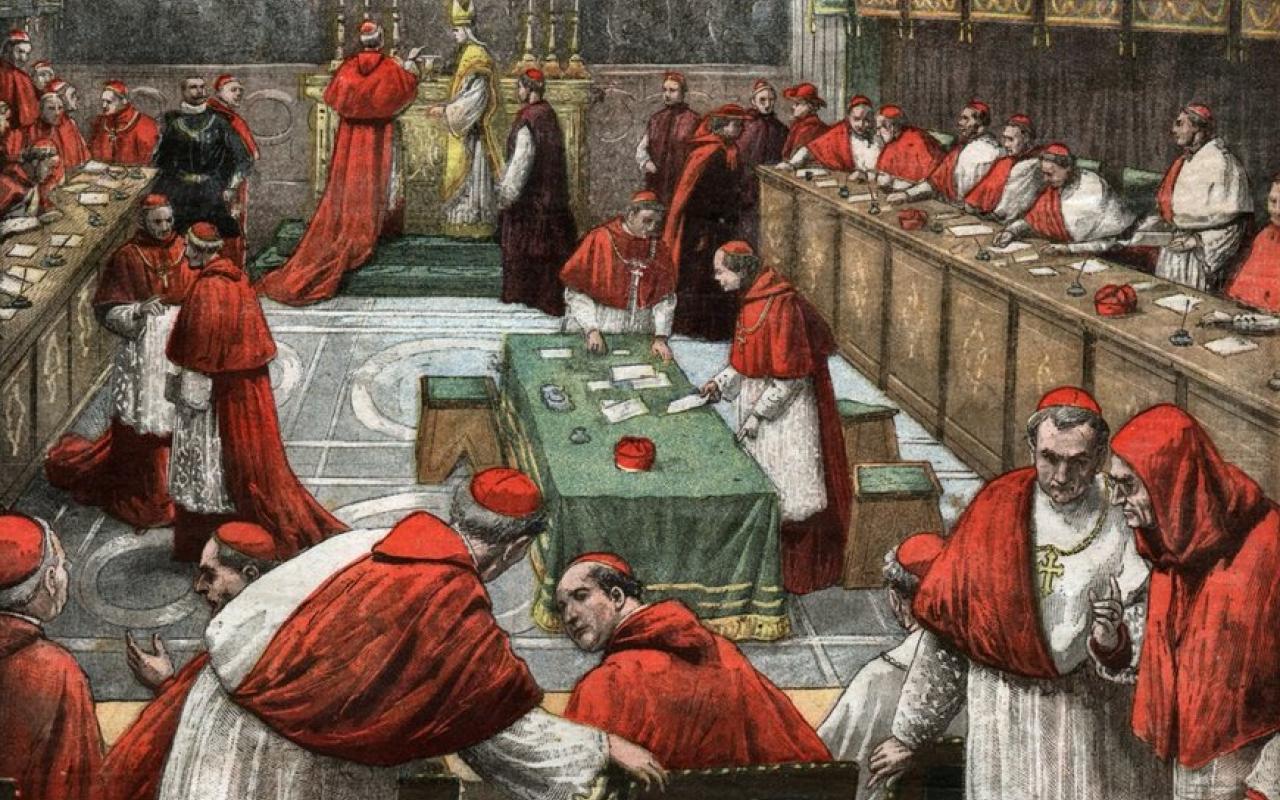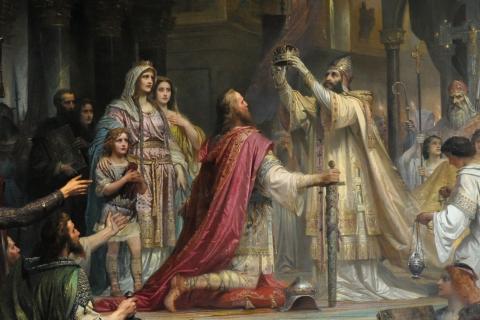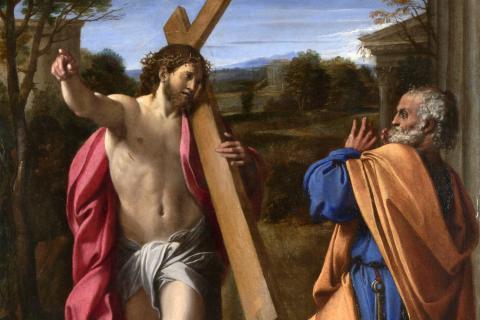
The Papal Conclave is a sacred process of spiritual discernment tasked with selecting the next pope, caught up in the tradition and Apostolic Succession of the Church.
This article is the fourth in a five-part series on the Papacy. The series begins with “Why Did God Give Us a Pope?”
Following the death or resignation of a pope, much work occurs in Rome for the good of the Church and the continuation of her mission. There is great hype by the media as speculation swirls about who the new Holy Father will be. Yet while the world often sees the death of a pope and the inauguration of his successor in political terms and even places bets about who will be elected, deeper realities are at work in how the mission of the Church continues under the grace of the Holy Spirit.
As the transition between papacies begins, the cardinals of the universal Church gather in Rome and begin General Congregation meetings for the planning of a papal funeral for the deceased pope. Additionally, arrangements begin for the start of the election that will provide a new pontiff, known as a conclave. According to the Church law provided by St. John Paul II in 1996, the conclave is to begin within fifteen to twenty days upon the vacancy of the See of Rome. This lapse in days provides time for the cardinal electors to travel and begin the necessary preparations.
The Latin word ‘conclave’ evokes images of the sealing with a key of the entire College of Cardinals. This secretive process has been in use since the Middle Ages, and while the secrecy might seem to shroud the Church in unnecessary mystery, it is designed to provide freedom for the cardinal-electors so that they are not unduly swayed by outside political, financial, or military influence. One might assume that this type of election is like a caucus system in which political factions are aligned and negotiations are conducted among heated debates. In truth, a papal conclave unfolds like a liturgical ritual, steeped in prayer and meditation that provides room for the electors to ponder what Christ is asking of His Church and how they will respond to the grace of God.
This gift of grace through the presence of the Holy Spirit in a conclave is not experienced in some extraordinary fashion, such as in visible wonders or audible locutions. The Church throughout the world offers intense prayers for the guidance of the cardinals by God’s grace during these sacred days. Yet the Holy Spirit descends upon the cardinals and guides their deliberations in the same fashion that the Holy Spirit guides many decisions within the Church. He does not treat us like robots, overrunning our own free decision capabilities. Instead, His grace draws us closer to Himself, prompting our will and intellect to new considerations and ideas. In this way, candidates will surface as potential pontiffs and new opportunities for the future of the Church will be considered in ways that respect the intellect and culture of each of the cardinals as they make their own unique contribution to the election of a new Vicar of Christ. The humanity of each cardinal is still very much involved in this process. The use of the imagination for the future of the Church, prudential judgment about potential candidates, and the voice of conscience about one’s moral responsibility in leadership are all at work during the voting process. Yet the Lord’s grace can illuminate the mind and heart to consider new possibilities among candidates and new paths of governance for the good of the People of God. In this way, cardinals who cooperate with the grace of the Holy Spirit will be led to give to the Church the pope that God desires. Such cooperation with grace aligns with the normal means by which all Christian believers are to discern the will of God in particular decisions.
Recent conclaves have provided housing for the cardinals in a Vatican City residence called the Domus Sanctae Marthae, and the election itself has occurred in the historic Sistine Chapel, decorated by the famous artist, Michelangelo. As the conclave gets underway, the cardinals process from the Pauline Chapel within the Apostolic Palace to the Sistine Chapel while singing the traditional chant, Veni Creator Spiritus. Upon gathering in the chapel, they take an oath upholding their responsibility toward the Apostolic See and the necessity to maintain secrecy from the outside world. This oath-taking takes on particular significance as the cardinals make it while standing before the large and dominating fresco by Michelangelo, The Last Judgment, which reminds them of the moral responsibility they bear before Christ and His Church. Only one vote is held on the opening day, while two ballots are cast each morning and each afternoon during the remaining days of the conclave. The names listed on the cast ballots are read and counted publicly by the cardinals in charge of the conclave process in a spirit of transparency. If no election occurs with an absolute majority after the first three days, the process is suspended by a day to provide time for greater prayer and discussion among the cardinal electors. The voting continues, with pauses for prayer as needed, until one candidate receives a two-thirds majority vote, at which point a Roman Pontiff has been validly elected. The elected pope is then asked if he accepts the Office and which name he will assume.
The ballots cast within the conclave election are burned after each round of voting in a small stove that is installed in the corner of the Sistine chapel. Chemicals are added to the fire that indicate to the outside world through color the results of each ballot. Black smoke seen coming from the chimney atop the Sistine Chapel indicates that an absolute majority was not reached in that particular ballot. White smoke indicates that a new pope has been elected, while the bells of St. Peter’s begin to ring and exuberant joy erupts throughout the crowd gathered in St. Peter’s Square and among those watching coverage online and through television. Upon the announcement of a new Pontiff’s name, the Holy Father is vested in his new papal cassock and zucchetto and receives the homage of each of the cardinals. Afterwards, he proceeds to the front balcony of St. Peter’s Basilica to greet the faithful and give his first Urbi et Orbi apostolic blessing, which extends to the city of Rome and the entire world.
It may seem odd that with all our modern technology, the results of the conclave are shared publicly using the ancient means of smoke signals. Some might cynically assume this is part of the Church’s proclivity to remain antiquated and incapable of responding to the contemporary world. Yet in truth, this practice retains the tradition of destroying the evidence of each cast ballot so as not to fuel needless speculation among the faithful on how the voting proceeded each round. It also maintains the needed seclusion among the cardinal-electors so as not to be influenced by anyone from the outside world.
In summary, we know that great excitement surrounds the election of a new pope. Speculation builds about what the future will hold or which candidates are more electable given certain political realities. Yet throughout this time of apostolic succession, faithful Catholics should keep their eyes fixed on the Lord. For just as He handed the keys of authority to St. Peter two-thousand years ago, so too will He entrust His Church to His new vicar. And this entrustment of authority is a continual unfolding of the tradition that has been handed down to us from the apostles. This process is not meant to exalt man, but rather, to serve the good of those who seek the Lord. During these days of transition, our prayer should intensify for this new shepherd of the Universal Church, that He will remain faithful to the invitation to feed Christ’s flock despite the heavy burden that is laid upon his shoulders. We should also pray that a spirit of unity fills the entire Church, so that during the historic moment of a papal election, we are bound together ever more closely through Christ the Good Shepherd.

